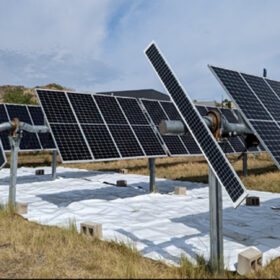All-perovskite tandem PV cell based on carboranes hits 27.2% efficiency
Researchers have developed a thermal regulation strategy to improve the performance of inverted tin-lead perovskite tech for all-perovskite tandem solar cells. It has an efficiency of 23.4% and contributed to a 27.2% efficiency in a tandem cell while ensuring stability.
US, Canada ramp up solar glass plans
With PV module capacity ramping up, glass suppliers have been investing in new solar glass production capacity. As in India and China, new facilities are popping up in North America, with unique twists to ensure competitiveness, such as using recycled material.
Cadmium-doped perovskite solar cell achieves 22.7% efficiency
A Chinese-Canadian research group has utilized for the first time a cadmium iodide doping technique to stabilize the blade coating process in the manufacturing of solar cells based on formamidinium lead iodide (FAPbI3) perovskite. The academics built a cell showing a considerable increase in efficiency compared to an identical device without cadmium doping.
3D printed clamps for front-surface PV mounting on wood racking
A research team proposed a new PV mounting solution relying on two types of spacers and two types of clamps that can be printed with common printing materials. The cost of the different solutions presented varies from CAD1.50 ($1.10) to CAD3.83.
Research shows high-albedo ground reflectors increase bifacial solar plant yield by up to 4.5%
Tests conducted by Canadian researchers at the NREL’s testing field in Colorado have shown that ground reflectors based on high-density polyethylene can significantly increase bifacial PV plant performance. They stressed the profitability of this technology is strictly dependent on the location and warned avoiding to combine it with inverter clipping.
PV-driven hybrid hydrogen fuel cell system for building applications
Scientist in Canada have proposed to combine rooftop PV power generation with an alkaline electrolyzer and a fuel cell to generate hydrogen in buildings. The new system is intended at enabling seasonal energy storage and reduce a home’s levelized cost of energy.
The Hydrogen Stream: Stadler finalizes longest hydrogen train test
Stadler says it has wrapped up a hydrogen train test, while Ballard has secured a long-term agreement to supply 1,000 hydrogen fuel cell engines through 2027.
The Hydrogen Stream: Companies to close 3 hydrogen stations in Germany
H2 Mobility’s live map has reported the planned closure of at least three hydrogen filling stations throughout Germany in the coming months, while the Japanese government has revealed plans to support the development of low-carbon aviation solutions, including hydrogen-combustion engines.
Quebec announces 300 MW solar tender
The government of the Canadian province of Quebec aims to deploy 300 MW of solar through tenders under utility Hydro-Quebec, in a bid to diversify the supply of renewables.
The Hydrogen Stream: Germany’s hydrogen strategy takes shape
Germany made progress with its hydrogen strategy, while Australia announced plans for a hydrogen feasibility study.










